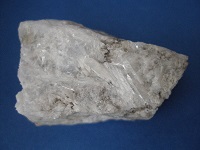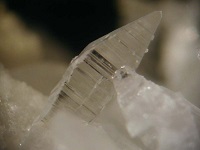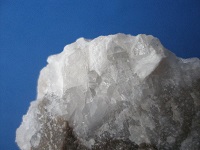based on E.H. Nickel & M.C. Nichols (2009), H. Strunz & E.H. Nickel (2001)
revised by Thomas Witzke (2024)
6. BORATES
6.E: Phylloborates
Biringuccite: Fundamental Building Block (FBB) (3Δ2□):<2Δ□>-<Δ2□>. The layers are built up of connected 3-membered rings of borate tetrahedra and triangles. The FBB as a motive in the layers contains 2 rings, <2Δ□> and <Δ2□>, sharing a tetrahedra. The same FBB can be found in the chain borate ezcurrite. The FBB's are connected via sharing vertices of tetrahedra and triangles to form a sheet. In each FBB the triangle not involved in the linkage between neighboring FBB's is pointing perpendicular to the layer. In the layer, the FBB's are arranged forming an irregular shaped 9-membered ring of borate tetrahedra and triangles. The layers are connected via Na cations (Corazza et al., 1974, Am. Min. 59, 1005-1015; Grice et al., 1999, Can. Min. 37, 731-762).
Nasinite: FBB (3Δ2□):<2Δ□>-<Δ2□>.
Gowerite: FBB (3Δ2□,1Δ):<Δ2□>-<2Δ□>,Δ. The same FBB as in Biringuccite and Nasinite, but with additional isolated borate triangles.
FBB (3Δ2□,1Δ):<Δ2□>-<2Δ□>,Δ.
Veatchite polytypes: Veatchite-1M (mon., P21, originally described as Veatchite-P), Veatchite-2M (mon, Aa), Veatchite-A (tric., A-1 or A1, originally described as a mineral, IMA 1978-030).
FBB (3Δ2□,1Δ):<Δ2□>-<2Δ□>,Δ.
FBB (3Δ2□):<Δ2□>-<2Δ□> and isolated sulfate tetrahedra.
 |  |  |
FBB (2Δ3□):<Δ2□>-<Δ2□>.
FBB (2Δ3□):<Δ2□>-<Δ2□> + extra sulfate tetrahedra.
 |  |  |
Studenitsite: FBB (4Δ5□), with [B9O14(OH)4]5- layers parallel (001). Corrugated layers of clusters of two three-membered borate rings of two different types. In one type, the clusters contain two triangles and three tetrahedra and the two rings share one tetrahedron. These clusters share 4 corners with neighboring clusters. In the other type, the clusters contain two triangles and two tetrahedra and the two rings share two tetrahedra. These clusters share two corners with neighboring clusters.
 |  |  |
FBB (3Δ3□):<Δ2□> | <Δ2□> | <Δ2□>. Sheets of clusters of three three-membered rings. All three rings share a central planar borate group. Two neighboring rings share additionally a tetrahedral borate group.
FBB (5Δ3□):<Δ2□> | <Δ2□> | <Δ2□> | 2Δ. The same FBB as in Nobleite, but decorated with a chain of 2 borate triangles.
FBB (8Δ6□), a combination of the FBB in Nasinite and Strontioborite.
 |  |  |
Preobrazhenskite: FBB (4Δ7□): □<Δ2□>-<Δ2□>-<Δ2□>-<Δ2□>□. The FBB contains four three-membered rings, connected in a linear arrangement via a shared tetrahedron and decorated at each end by a tetrahedron. The FBB's are connected to form a corrugated sheet parallel (010) (Grice et al., 1999, Can. Min. 37, 731-762).
 |  |  |
Fabianite: FBB (2Δ4□): <Δ2□>=<4□><Δ2□>=<Δ2□>. The FBB contains a four-membered ring <4□>, that shares two trans edges with two three-membered rings. The resulting cluster has four borate tetrahedra and two triangles. These FBB's link by sharing two tetrahedron and two triangle vertices with adjacent clusters to form a corrugated sheet (Grice et al., 1999, Can. Min. 37, 731-762).
 |  |  |
Halurgite: FBB (4Δ4□). Eight B polyhedra form a FBB [B8O16(OH)2], which is a six-membered borate ring built by two pairs of B tetrahedra and two B triangles, with two additional triangular BO2(OH) groups. Each [B8O16(OH)2] ring is linked to six adjacent analogous rings to form a [B8O13(OH)2] layer. These layers are connected via MgO6 and Mg(OH)2(H2O)4 octahedra into a microporous heteropolyhedral pseudo-framework (Pekov et al., 2019, Min. Mag. 83, 1-25).
 |  |  |
Peprossiite-(Ce): Sheets of 6-membered rings of tetrahedra. The topology of the sheets is identical to that of mica.
Johachidolite: FBB (8□): <6□>=<4□>. Layers bases on the FBB of a six-membered ring of tetrahedra that shares an edge with a four-membered ring of tetrahedra.
 |  |  |
Brianroulstonite and Popugaevite: (6Δ6□).
Walkerite: highly corrugated sheets of borate polyhedra are cross-linked by Ca and Mg polyhedra.
G = Grandfathered minerals: original description preceded the establishment of the CNMNC in 1959, and generally regarded as a valid species
A or IMA No. = Minerals approved by the CNMNC
Rd = Redefinition of the mineral approved by the CNMNC
Rn = Renamed with approval by the CNMNC
Q = Questionable mineral
Classification principles:
The classification is based on the linkage of borate triangles (BO3), symbol Δ, and borate tetrahedra (BO4), symbol □, to form fundamental building blocks (FBB) (see in Grice et al., 1999). According to the polymerization of the borate groups the subdivision is made now into Neso-, Soro-, Cyclo-, Ino-, Phyllo- and Tecto-borates, adapted from the well-known subdivision of the Silicates class and following the recommendation in Mills et al. (2009) on the standardization of mineral group hierarchies.
Phylloborates are minerals with infinite layers of connected borate groups. The classification follows the principles in Grice et al. (1999), from simple FBB's with single 3-membered rings, pairs of 3-membered rings, triplets of 3-membered rings, 4-membered rings, 6-membered rings to larger rings. Within the same ring size sorted according to increasing number of tetrahedra:
6.EA. Phylloborates with sheets of 3-membered rings of tetrahedra + triangles, FBB (3Δ2□), and derivatives: With sheets built up of connected 3-membered rings; layers built up of connected 3-membered rings + additional isolated borate groups.
6.EB. Phylloborates with sheets of 3-membered rings of tetrahedra + triangles, FBB (2Δ3□), and derivatives: With sheets built up of connected 3-membered rings; layers built up of connected 3-membered rings + additional isolated sulfate groups.
6.EC. Phylloborates with sheets of clusters with pairs of three-membered rings of tetrahedra + triangles, FBB (4Δ5□): Only one mineral.
6.ED. Phylloborates with sheets of clusters with triplets of three-membered rings of tetrahedra + triangles, FBB (3Δ3□), and derivatives: With triplets of three-membered rings; with triplets of three-membered rings + attached borate groups.
6.EE. Phylloborates with sheets of clusters with other arrangements of three-membered rings: FBB (4Δ7□): Only one mineral.
6.EF. Phylloborates with sheets of clusters with four-membered (and three-membered) rings: FBB (2Δ4□): Only one mineral.
6.EG. Phylloborates with sheets of clusters with six-membered rings of triangles and tetrahedra: FBB (4Δ4□): Only one mineral.
6.EH. Phylloborates with sheets of clusters with six-membered rings of tetrahedra, FBB (6□), and derivatives: FBB (8□): With 6-membered rings of tetrahedra; with 6-membered rings of tetrahedra + 4-membered rings.
6.EJ. Phylloborates with sheets based on FBB's with rings of more than 6 borate groups: Only two groups.
Reference:
Grice, J.D.; Burns, P.C. & Hawthorne, F.C. (1999): Borate Minerals. II. A hierarchy of structures based upon the borate fundamental building block. Can. Min. 37, 731-762.
Mills, S.J.; Hatert, F.; Nickel, E. & Ferraris, G. (2009): The standardisation of mineral group hierarchies: application to recent nomenclature proposals. Eur. J. Mineral. 21, 1073-1080.
To distinguish from classical Strunz numbering, on hierarchical "group" level, a numbering with 3 digits is used, like "6.EA.005. Biringuccite", instead of 2 digits (like "6.EA.05.") in the Strunz system.
© Thomas Witzke (2024)
